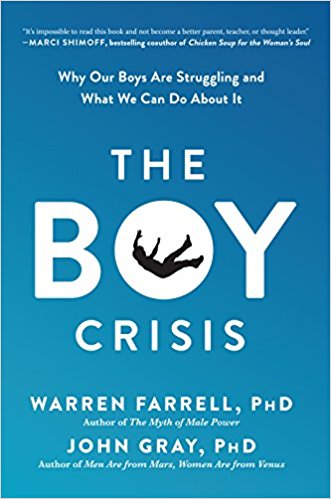
Start of School Very Different for Parents of Boys, Parents of Girls
By Glenn Sacks. This column appeared in the Washington Times (9/12/04), the Albuquerque Journal (9/10/04), and the Omaha World-Herald (9/4/04).
We received the notices for my son's and daughter's school in the mail yesterday. My soon-to-be-first grade daughter jumped up and down, wanting to know who her new teacher will be, what room she will be in, and "when do we get to start?" My middle school son examined his letter, and optimistically noted, "the first week is mostly minimum days, except for a Friday, but that's almost the weekend, when there's no school. So the week will go by quickly."
I called my son's old school, which my daughter will now be attending, to ask a question. The women in the office all know me. My name is associated with discipline problems in class, inappropriate mischief on the yard, and calls home to dad. I hear the slight apprehension in the secretary's voice.
"Don't worry, you won't have any problems this time," I tell her apologetically. "This is my daughter."
Modern schools are the land of "girl good, boy…." well, not bad, maybe, but a problem to be solved. Of "If only he would…" and "someday he'll…" and, my favorite, "he's a nice boy, but…"
Simply put, modern schools are not boy-friendly. This can be seen from the time boys enter school, when many of them are immediately branded as behavior problems. The line of elementary school kids who used to gather every day after school in my son's class for their behavior reports--all boys. The names of kids on the side of the chalkboard who misbehaved and would lose recess--all boys. The nine million children, many as young as five or six, who are given Ritalin so they will sit still and "behave"--almost all boys.
Girls get better grades than boys, and boys are far more likely than girls to drop out of school or to be disciplined, suspended, held back, or expelled. Boys are four times as likely to receive a diagnosis of attention-deficit hyperactivity disorder as girls, and the vast majority of learning-disabled students are boys. By high school the typical boy is a year and a half behind the typical girl in reading and writing.
Modern K-12 education is not suited to boys' needs and learning styles. Success in school is tightly correlated with the ability to sit still, be quiet and complete work. The fact that many young boys are bodily kinesthetic learners who crave physical, hands-on and energetic lessons is inconvenient, and is thus largely ignored.
The trend against competition and the promotion of cooperative learning strategies run counter to boys' natural competitiveness and individual initiative. Group projects and lessons in which there are no right or wrong answers, and from which solid conclusions cannot be drawn, tend to frustrate boys, who often view them as pointless.
Efforts to make schools gentler and to promote women's writing, while understandable, have pushed aside the action and adventure literature which boys have treasured for generations. In their place are subtle, reflective works which often hold little interest for boys.
The dearth of male teachers--particularly at the elementary level, where female teachers outnumber male teachers six to one--is a problem for boys. The average teacher is a well-meaning and dedicated woman who always did well in school and simply cannot understand why the boys won't sit still, be quiet and do their work. Instead, boys need strong, charismatic teachers who mix firm discipline with an understanding and good-natured acceptance of boyish energy.
Another problem is that teachers are weighed down by paperwork and secretarial labor which limits the amount of time they can spend planning and delivering creative, hands-on, boy-friendly lessons.
Perhaps most importantly, there is little outlet for natural boyish energy and exuberance in schools. Recess and physical education time allotted during the day are insufficient for boys' needs, and the trend has been to reduce this time rather than to increase it.
The educational establishment has reacted to the boy crisis in education in a way reminiscent of Bertolt Brecht's famous poem about calls to reform or dissolve the unpopular government of East Germany: the government found it difficult to reform itself, so would instead choose to "dissolve the people and elect another."
Similarly, rather than reform a system woefully out of touch with boys' real world natures and needs, our schools find it easier to demand that boys be something other than boys.
Glenn Sacks is a men's and fathers' issues columnist and a nationally-syndicated radio talk show host. His columns have appeared in dozens of America's largest newspapers.
He taught elementary school and high school in Los Angeles Unified School District and others, and was named to "Who's Who Among America's Teachers" twice.
Glenn can be reached via his website at www.GlennSacks.com or via email at Glenn@GlennSacks.com
For more information about Glenn's talk radio show His Side with Glenn Sacks visit www.HisSide.com
Copyright 2001-2004. Glenn Sacks. All Rights Reserved.




